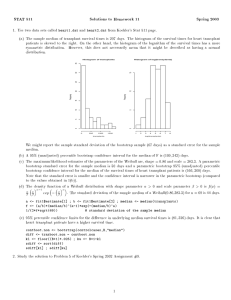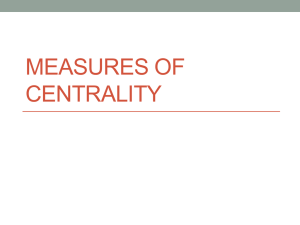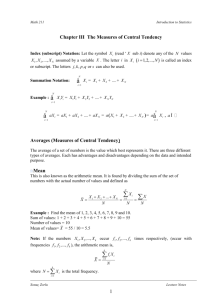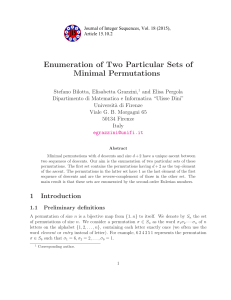Analysis of Approximate Median Selection
advertisement
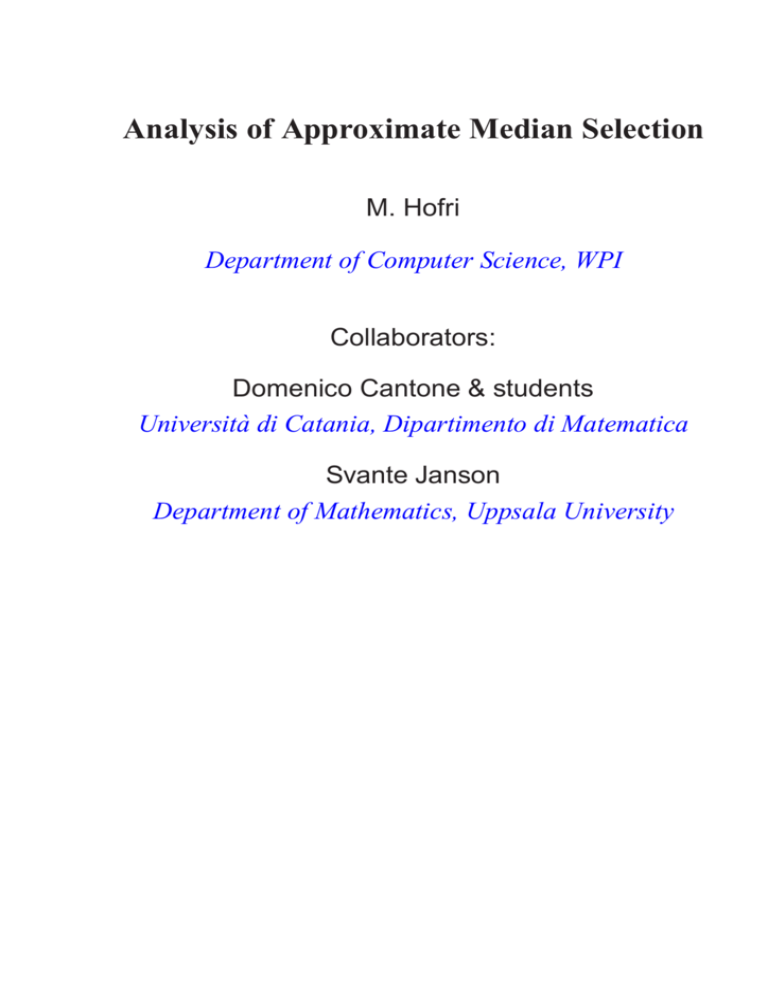
Analysis of Approximate Median Selection M. Hofri Department of Computer Science, WPI Collaborators: Domenico Cantone & students Università di Catania, Dipartimento di Matematica Svante Janson Department of Mathematics, Uppsala University 2 Finding the median efficiently — a difficult problem. A deterministic algorithm for the exact median was improved in 5/99 by Dor & Zwick, requiring (in the worst case) ≈ 2.942n. Extremely involved . . . For expected number of comparisons: Floyd & Rivest showed (1975) it can be done in (1.5 + o(1))n. Cunto & Munro (1989): this bound is tight. Our algorithm was developed in 1998 by Cantone — and only much later we discovered that several formulated various analogues earlier — as early as 1978! Deterministic, uses at most 1.5n comparisons, and the expected number is 4/3n. Major virtue: extremely easy to implement (and understand) — but it only approximates the median. Sicilian Median Selection 3 12 22 26 13 21 7 10 2 16 5 11 27 9 17 25 23 1 14 20 3 8 24 15 18 19 4 6 s + 22 13 10 11 17 14 8 18 6 U 13 14 8 ? 13 This is performed in situ. Essentially the same algorithm can be done “online:” processing a stream of values and using workarea of 4 log3 n positions. 4 Analysis — Cost of search Finding median of three requires 2 comparisons in 2 permutations, 3 comparisons in 4 permutations, — out of the 6 possible permutations. Hence E[C3] = 8/3. The expected total number of comparisons when looking in a list of size n: n 8 n C3(n) = · +C3( ), 3 3 3 C3(1) = 0 Result: C3(n) = 43 (n − 1). The number of elements that are moved is similarly E3(n) = 13 (n − 1). The number of three-medians computed: 1 (n − 1). 2 Sicilian Median Selection 5 Analysis — Probabilities of selection To show that the selected median – Xn – is likely to be close to the true median we need to compute the distribution of the rank of the selected entry, Xn. Let n = 3r . (r) def The key quantity is qa,b = the number of permutations, out of the n! possible ones, in which the entry which is the ath smallest in the array is: (i) selected, and (ii) has rank b ( = is the bth smallest) in the next set, that has n3 = 3r−1 entries. The counting is performed in two steps: 1. Count permutations in which a is chosen in the bth triplet, and all the entries chosen in the first b − 1 triplets are smaller than a, and all the items chosen in the rightmost n/3 − b triplets are larger that a. 2. Compensate for this restriction: multiply the result of step one by the number of rearrangements of 6 such permutations: (n/3)! (b−1)!( n3 −b)! = n n 3 −1 3 b−1 . The first step is not that simple, and it produces the following expression, 2n(a − 1)!(n − a)!3a−b ∑ i n b−1 1 3 −b . i a − 2b − i 9 i We find: (r) qa,b n − 1 a−b−1 3 = 2n(a − 1)!(n − a)! 3 b−1 n − br b−1 1 3 × ∑ . i 9 a − 2b − i i i (r) (r) The related probability: pa,b = qa,b/n!: n (r) pa,b = −b 3 −1 3 2 b−1 · n−1 −a 3 3 a−1 ×∑ i n b−1 1 3 −b a − 2b − i 9i i n = −b 3 −1 2 3 b−1 · 3 3−a n−1 a−1 × [z a−2b n −b z b−1 ](1 + ) (1 + z) 3 . 9 Sicilian Median Selection 7 (r) Finally, Pa : the probability that the algorithm chooses a from an array holding 1, . . . , n = 3r . (r) (r) (r−1) Pa = ∑br pa,br Pbr For Pa(r) = ∑ br ,br−1 ,··· ,b3 (r) (r−1) (2) pa,br pbr ,br−1 · · · pb3,2 2 j−1 ≤ b j ≤ 3 j−1 − 2 j−1 + 1. r a−1 2 3 n−1 = 3 a−1 × r ∑ ∏ ∑ br ,br−1 ,··· ,b3 j=2 i j ≥0 j−1 bj − 1 3 − bj 1 b j+1 − 2b j − i j 9i j ij b j ∈ [2 j−1 . . 3 j−1 − 2 j−1 + 1], b2 = 2 and br+1 ≡ a. No known reduction . . . Numerical calculations produced: 8 n r = log3 n σd Avg. σd /n2/3 9 2 0.428571 0.494872 0.114375 27 3 1.475971 1.184262 0.131585 81 4 3.617240 2.782263 0.148619 243 5 8.096189 6.194667 0.159079 729 6 17.377167 13.282273 0.163979 2187 7 36.427027 27.826992 0.165158 Variance ratios for the median selection as function of array size d is the error of the approximation: n + 1 d ≡ Xn − 2 What can we expect when n grows? Sicilian Median Selection 9 0.25 0.2 0.15 0.1 0.05 0 8 10 12 14 16 18 Plot of the median probability distribution for n=27 20 10 0.04 0.035 0.03 0.025 0.02 0.015 0.01 0.005 0 20 40 60 80 100 120 140 160 180 Plot of the median probability distribution for n=243 200 220 Sicilian Median Selection 11 To answer the last question we look at a “similar” situation, where we look at n independent random variables: Ξ = (ξ1, ξ2, . . . , ξn), ξ j ∼ U(0, 1). Ξ is a permutation of their sorted order, S(Ξ): S(Ξ) = (ξ(1) ≤ ξ(2) ≤ · · · ≤ ξ(n)). Observation: If the Sicilian algorithm operates on this permutation of Nn , and returns Xn = k, then sicking it on Ξ would return Yn = ξ(k). The idea: Yn tracks Xnn , but—due to the indpendence of the n variables ξi—it has a simpler distribution. 12 How good is the tracking? ES Yn − 1 − 2 Xn − n+1 2 Condition on the sampled value: 2 n 2 Xn − 1/2 = ES Yn − n k − 1/2 2 1 = Ek ξ(k) − . n 4n And the variance of |Dn|/n is larger, and decreases more slowly! We said Yn is simpler. . . How simple is it? Fr (x) ≡ Pr(Yn − 1/2 ≤ x), − 1/2 ≤ x ≤ 1/2, n = 3r . F0(x) = x + 1/2. Now we need a recurrence: Y3n is the median of 3 independent values ∼ Yn, hence Fr+1(x) = Pr(Y3n ≤ x + 1/2) = 3Fr2(x)(1 − Fr (x)) + Fr3(x) = 3Fr2(x) − 2Fr3(x). Sicilian Median Selection 13 A simpler form is obtained by shifting Fr (·) by 1/2; Gr (x) ≡ Fr (x) − 1/2 =⇒ G0(x) = x, We get our first key equation: Gr+1(x) = 32 Gr (x) − 2G3r (x). But it is not interesting! it is satisfied by 1 −2 Gr (x) = 0 1 x<a x=a x>0 2 This says: Dn n → 0, def Dn = Xn − n+1 2 . Need change of scale. We showed, 2 1 µ E Yn − 2 − Dn/n → 0 2r ∀µ ∈ [0, √ 3). Hence we can track µr (Dn/n) with µr (Yn − 1/2). We pick a convenient value, µ = 3/2 and show: 14 Theorem [Svante Janson] Let n = 3r , r ∈ N. Xn — approximate median of random permutation of N n. Then a random variable X exists, such that r 3 Xn − n+1 2 2 n −→ X, where X has the distribution F(·); with the same shift F(x) ≡ G(x) + 1/2, we get the equation 3 3 G( x) = G(x) − 2G3(x), 2 2 −∞ < x < ∞ Moreover: The distribution function F(·) is strictly increasing throughout. The value 3/2 is inherent in the problem! Sicilian Median Selection 15 The proof of the Theorem uses the technical lemma Lemma Let a ∈ (0, ∞) and φ that maps [0, a] into [0, a] For x > a we define φ(x) = x. Assume (i) φ(0) = 0 (ii) φ(a) = a (iii) φ(x) > x, for all x ∈ (0, a). (iv) φ (0) = µ > 1, and continuous there; φ(·) is continuous and strictly increasing on [0, a). (v) φ(x) < µx, x ∈ (0, a). Let φr (t) = φ(φr−1(t)), the rth iterate of φ(·). Then as r −→ ∞, φr (x/µr ) −→ ψ(x), x ≥ 0. ψ(x) is well defined, strictly monotonic increasing for all x, increases from 0 to a, and satisfies the equation ψ(µx) = φ(ψ(x)). Proof: From Property (v): φ(x/µr+1 ) < x/µr , Since iteration preserves monotonicity, φr+1 (x/µr+1 ) = φr (φ(x/µr+1)) < φr (x/µr ). Hence a limit ψ(·) exists. 16 The properties of ψ(x) depend on the behavior of φ(·) near x = 0. Since φ(x) is continuous at x = 0, ψ(·) is continuous throughout. Since it is bounded, the convergence is uniform on [0, ∞]. Hence, since φ(·) and all its iterates are strictly monotonic, so is ψ(·) itself. We have then the equation 3 3 −∞ < x < ∞ G( x) = G(x) − 2G3(x), 2 2 but we have no explicit solution for it. What can we do? Several things. We can calculate a power expansion for it; From G0(·) and the iteration, all Gr (·) are odd, hence we can write G(x) = ∑ bk x2k−1. k≥1 b1 is avaiable from the iteration: The derivatives of Gr (x/µr ) are all 1, hence this is also the derivative there of G(x). Successive calculations are easy: Sicilian Median Selection 17 k bk 1 2 1.00000000000000 × 10+00 −1.06666666666667 × 10+00 3 4 5 6 1.05025641025641 × 10+00 −8.42310905468800 × 10−01 5.66391554459281 × 10−01 −3.29043692201665 × 10−01 7 8 9 1.69063219329527 × 10−01 −7.82052123482121 × 10−02 3.30170547707520 × 10−02 10 −1.28576608229956 × 10−02 11 4.65739657183461 × 10−03 12 −1.57980373987906 × 10−03 13 5.04579631846217 × 10−04 14 −1.52443954167610 × 10−04 15 4.37348017371645 × 10−05 20 −4.33903859413399 × 10−08 25 1.70629958951577 × 10−11 30 −3.20126276232555 × 10−15 40 −1.94773425996709 × 10−23 50 −1.85826863188012 × 10−32 60 −4.03988860877434 × 10−42 The fit of F(·)—calculated using the first 150 bk — to the distribution of Xn/n is poor for n in the low hundreds but improves very fast. We show an example later. 18 Fact: it is very close to Normal, with mean zero and √ σ = 1/ 2π – but not quite! We can investigate how similar it is by looking at the tail of the distribution — the complementary function g(x) ≡ 1 − F(x). It satisfies 2 2 2 3 g(xµ) = 3g (x)−2g (x) =⇒ 3g(xµ) = (3g(x)) 1 − g(x) . 3 since 0 < g(x) < 1: 1 (3g(x))2 < 3g(xµ) < (3g(x))2 3 This is all we need in order to show that the tail of the distribution of Xn/n is −dt v e 1 −ct v < g(t) < e 3 c ≈ 3.8788, d ≈ 4.9774 v ≈ 1.70951 c = ln (1 − F(1)) ; v = ln 2/ ln(3/2), d = c + ln 3, whereas the Normal distribution decays much faster: its tail is −0.5x2 /(2πx). 1 − Φ(x) ∼ e Sicilian Median Selection 19 Example: From simulation, at n = 1000, 95% of the values of D1000 fell in the interval [−58, 58]. From the “tracking claim” we have Dn ∼ nX/µr . Also n/µr = 3r /(3/2)r = 2r = nln(2)/ ln(3) ≈ n0.63092975. And then Pr[|Dn| ≤ d] ≈ Pr[|X| ≤ dµr /n] =⇒ Pr[|D1000| ≤ 58] ≈ Pr[|X| ≤ 0.7424013] ≈ 0.934543. This was calculated using the power series development. When using the upper bound on the tail we similarly find Pr[|D1000| ≤ 58] = 1 − 2g(0.7424013) 2 1.7095113 ≈ 0.935205. ≈ 1 − exp −3.878797 × 0.7424 3 20 Open problems: 1. A better characterization of the solution for G(x). 2. An explicit value for the variance of the limiting d distribution; From the relation µr (Yn − 1/2)−→X we can numerically iterate the transformation and find that it is about 2–3% larger than 1/2π, but an exact value is not easy. 3. A much taller order: compute the quality of a derivative algorithm, that produces an approximate fractile Xk/n for any 1 ≤ k ≤ n. This can be done by filtering the initial values: for example, by picking the 23rd from each set of 28 initial values, and then finding their median, we approximates the fractile X0.8n of the original data.
